Most of January has been dry. The rain total this month is just under 3 inches, but almost all of this month’s precipitation fell during two brief storms, and it’s a far cry from the 8 inches that fell last January. With the exception of yesterday’s storm, for most of the last few weeks it’s been dry, sunny, and wonderfully warm for the middle of winter. Not that I’m complaining, we should all have such problems, but it is making finding fungus for Mushroom Mondays somewhat challenging.
Despite the beautiful weather, this morning’s hike did yield a species that I haven’t seen here before.
Clavulinopsis laeticolor is a type of club fungus. The fruiting bodies of this specimen were spied just below a live oak, but initially I missed it. My attention wasn’t drawn to their yellow color…but rather to this yellow object instead.
Once I crouched down close to the ground though I realized this Banana Slug was mere inches from this similarly colored fungus.
This tiny species is widely distributed across North America, Asia and Europe, and may be seen in summer and fall, or in winter in warmer climates.
Clavulinopsis laeticolor tends to grow singly, or in sparse loose clusters in mid to late winter. Despite its bright color, its tiny size means it doesn’t hold much presence amid the drab browns and greens of the forest floor.
This is a helpful distinguishing feature, as its similar appearing cousin, Clavulinopsis fusiformis, does grow in tight dense clusters, standing out more readily amidst its less vibrant neighbors.
The fruiting bodies of Clavulinopsis laeticolor are orange-yellow in color, and generally cylindrical in shape. Unlike some species of club and coral fungi, there is no branching, although the fruiting bodies may be grooved longitudinally or even somewhat twisted in form.
This fungus grows between 1-7 cm in height, but less than 5 mm in width. Due to its diminutive size, and bitter taste, Clavulinopsis laeticolor is considered inedible.
Hopefully, yesterday’s wet weather will bring forth another fungus worthy of featuring next Monday. In the meantime, the orchard, gardens and weeds beckon.

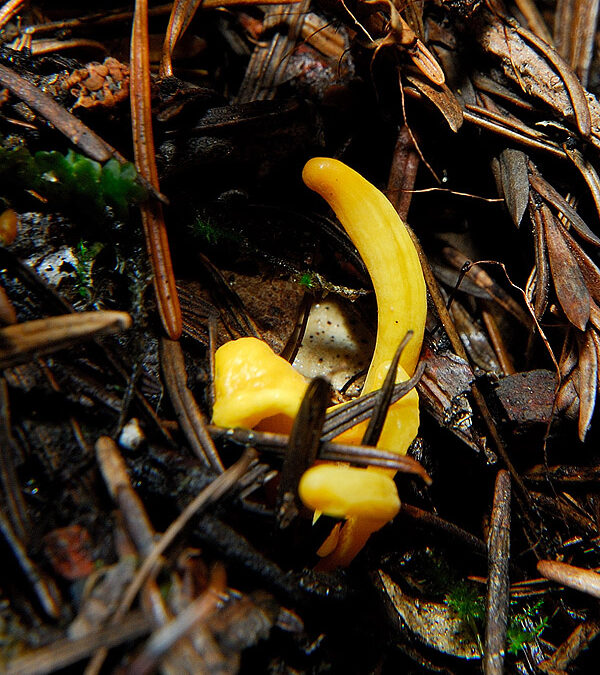
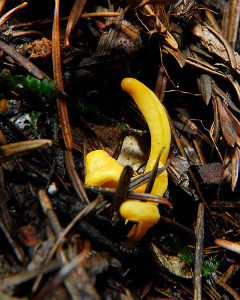

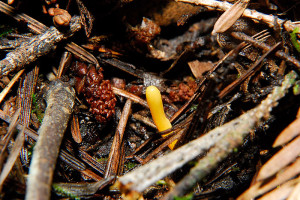
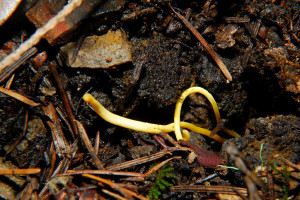
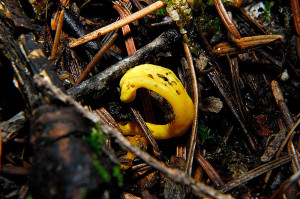
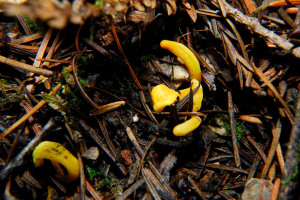







I’ve been brought to my knees a number of times by those club fungi. I have photos of some stashed somewhere.
Definitely an on-your-knees fungus, they’re tiny! I honestly wouldn’t have seen them if I hadn’t stopped to look at the slug 😛
That is a lot of yellow. I have never seen the Club fungus or the banana slug before. Really interesting and glad I saw something new.
I hadn’t seen the fungus before, but here, banana slugs are the predominant slugs. They are actually quite beautiful, for slugs, and our redwood forests are dependent on them.
Clare I think you might have just helped me ID a photo that I have in my archives. I photographed something similar to this in October like little thin fingers poking just out of the grass though my camera was more interested in focusing on the blades of grass rather than the yellow. I’ll investigate a little further now that I have a name and see if this type of fungus is known in my area. Thanks, Rosie
There’s a good chance it’s the same one. It’s quite common. I never paid any attention to fungus when I lived in England, so I have no idea what actually grows. I’ll be curious though, let me know what you find out!
Fascinating photos. I’m guessing many folks (me included) would walk right over the fungus without spying it. The banana slug is another story! Glad we don’t have them in our neck of the woods.
The fungus is easy to miss. The slug however is like a large yellow neon blob slithering across the redwood duff, and impossible to miss. This was a sizable fellow, albeit bashful. He really didn’t want his photo taken!
Dear Clare, The Banana Slug…..now that certainly is a new one for me. I have never heard of this yellow peril before. It certainly stands out in the undergrowth so it is easy to spot. Is its appetite as voracious as its more dreary grey relatives?!!
Edith, these slugs actually almost never appear in the garden. I find them on the porch from time to time, but they don’t bother my plants. They really seem to prefer forest fare, and actually, if you saw a brown garden slug as large as these, you’d be shocked. This fellow was at least as long as my hand! Good thing I don’t see them in the lettuce patch!
Hi Clare, the similarity of the fungus you feature today to a slug of any variety would prevent me from becoming fond of it, I fear. Although I have read that banana slugs aren’t as damaging as other varieties – is that true? Thanks for your warning about being enticed to malicious sites. Barbara
You’re right Barbara, they’re not as damaging. As far as slugs go, I’d much rather have these fellows about than your common garden variety. They’ve never been a problem in the garden, not even in the vegetable garden. They’re important forest recyclers, and it’s believed by some that without the Banana Slug, our Redwood forest ecosystem wouldn’t be the same. Come to think of it, I don’t really ever see slugs that aren’t yellow here. We have gophers, bunnies, voles, deer…but at least we don’t have the bad slugs!
What fun! I’m sure you’ll get more fungus for next Monday. BTW, we only got .5 inches all month, so you’re ahead of us.
As for banana slugs, I do, of course, adore them. Who wouldn’t?
That’s interesting TM, as you’re not that far from me. However, we are on the windward side of the mountain though. We had 2.87 inches in January, compared to your 0.5. I actually had to water the garlic last week because it had been relatively dry here. I do hope, for our newly planted natives, that we get a little a more rain. Some extra mushroom posts would be welcome too 😉 I agree, I love banana slugs too!
Indeed eye-catching, Clare … this series is most interesting!
Except for the wallflowers, these are the only yellow things here at the moment!
Both the banana slug and the fungus are new to me; how cool that they were together. I wonder if the slug was attracted by the yellow color of the fungus, thinking perhaps it was a potential mate? ( Do slugs mate? They must do something!)
Slugs do mate Deb, although they are hermaphroditic, just to ‘complicate’ matters. I did wonder if it was more than mere coincidence that I found the slug right next to this mushroom. I think I found the answer in our own banana slugs post though:
https://curbstonevalley.com/blog/?p=481
In that post I mentioned that “Mushrooms are considered to be a particular delicacy in the banana slug diet”…so I’m guessing he/she was hungry! I’ll have to walk back out there later this week, and see if that fungus has since been devoured! 😀
LOL, Clare, I was skimming your photos before I read the text and thinking, “Wow, that fungus looks just like a slug!” Turns out the photo I was looking at was a slug.
It’s really a gorgeous yellow. I am sure I don’t want any slugs, no matter how pretty colored that are, that are a hand length long in my garden! gail
Wow, I’m in awe of the teeny fungus — but even more in awe of the banana slug. It looks like a tropical transplant! I’ve never seen such a thing, and I’m frankly fascinated.
This is one of those “must show to F. ASAP” posts.
How cool! I’ve seen club fungus here but our local slugs are not nearly as bright. (My daughter feels very disappointed about it after seeing your photo).